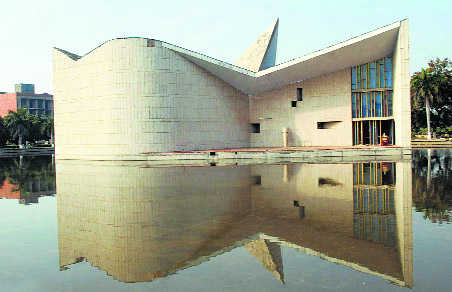The harm caused to Haryana for not having its own capital city, where Haryanvi culture could be valued and developed, has been deep. A new capital can have a new university suited to the needs of Haryana and resolve the PU status row.
Pritam Singh
Professor, Oxford Brookes University, Oxford, UKIn the context of the Haryana Chief Minister recently urging the Centre for restoration of Haryana’s share in Panjab University, Chandigarh, and its rebuttal by the Punjab CM, it is important to grasp the historical background. Panjab University, Chandigarh, is an inter-state body with hundreds of colleges in Punjab affiliated to it along with many regional centres of the university in different parts of Punjab. These colleges and regional centres are crucial to its functioning — administratively, academically and financially. They are at the core of the identity of PU. The funding of the university is shared between the Punjab government and the Central government, with a major part coming from the latter as the university is situated in Chandigarh which, unfortunately, is a Central government-controlled union territory since the flawed linguistic reorganisation of Punjab in 1966. Chandigarh is overwhelmingly a Punjabi-speaking city. This is an unquestionable social reality. To satisfy the conditions for empirically-based conclusions, the late Prof VN Tiwari had established the Punjabi-speaking character of Chandigarh through a survey of languages spoken by Chandigarh residents. He had published a book titled The Language of Chandigarh in 1967 based on that survey. The majority of Chandigarh residents are from the upper caste Punjabi Hindu background. While demarcating the boundaries of Punjab and Haryana during the linguistic reorganisation of pre-1966 Punjab, if the Central government had stuck to the linguistic principle, as it should have, Chandigarh would have been in Punjab. Had that been done, PU would have been in Punjab.Unfortunately, the religious/communal criterion was given prominence over the linguistic criterion and Chandigarh was allotted originally to Haryana. But sensing an explosive backlash in Punjab at this blatant discrimination, the city’s status was converted into a union territory. The glaring nature of the injustice to Punjab is clear from the fact that in the history of linguistic reorganisation of states in India, Punjab is the only state which upon such reorganisation was not allowed to keep its capital. On the face of it, a somewhat genuine attempt at undoing this injustice was made with the Rajiv-Longowal Accord in 1985 which stipulated that the first major step in implementing the Accord for peace in Punjab would be giving Chandigarh back to Punjab on January 26, 1986. That was not done under pressure of anti-Punjab lobbies within the Congress party which succeeded in influencing the Rajiv government that giving Chandigarh to Punjab would alienate Hindu voters in Haryana, with a cascading effect on Hindu voters in the neighbouring states in the Hindi belt. The communal/sectarian considerations again triumphed as they had in 1966. The Accord was dead that day and Punjab went into over a decade of further turmoil and violent conflict. The limbo status of Chandigarh as a UT and a joint capital city of Punjab and Haryana, apart from perpetuating injustice to Punjab, is not in the interests of educational and cultural development of Haryana. One of the ugly aspects of the regional dimensions of the Centrally-directed development path followed in post-1947 India that had implications for Punjab and Haryana was that the Punjabi elite that ruled Punjab from 1947 to 1966 treated Haryana almost as a colony for governance and took hardly any interest in the cultural, artistic and intellectual development of the Haryana people. Once freed from the shackles of Punjabi dominance in 1966, Haryana made impressive achievements in agriculture and industry. Where it did not do as well were the cultural, artistic and intellectual domains. One glaring institutional gap in the new state for its cultural development was the absence of a state capital. A capital is not merely a set of buildings and administrative offices. It is supposed to be the nerve centre of the culture and life of the people of the state where people belonging to different zones of the state come together with a common identity. The capital city is a space of cultural identity and flowering of that identity. It is a creative venue for collective exploration and celebration of the songs, dances, paintings, sculptures, architectural experiments, theatre, films, museums, the collection of memory of the people through historical narratives — all relating to the people of the state and their relationship to the wider world. Chandigarh has the administrative offices as the capital of Haryana, but the city has no organic link with the people and culture of Haryana. The people of Haryana, their language and culture are viewed with contempt by the Punjabi-hegemonic culture of Chandigarh. Chandigarh may not be de jure capital of Punjab but culturally, it is de facto the capital city of Punjab. For the cultural renaissance of Haryana, having a capital city of its own, perhaps a new one, in an area of Haryanvi culture is of critical importance. One intellectual, DR Chaudhry, has had the wisdom to articulate this position once in these words: “Haryana badly needs a capital of its own and Chandigarh is the least suited for this purpose. It is a dead albatross around its neck. The earlier it is shed, the better it will be for Haryanvis.” Such a capital city can have a new university suited specifically to the cultural and educational needs of Haryana.A rationally arrived decision between the Centre, Punjab and Haryana to develop a new capital city for Haryana and giving Chandigarh back to Punjab would be of critical importance in reversing the damage done both to Punjab and Haryana. Such a solution will automatically resolve the question of the status of Panjab University.
